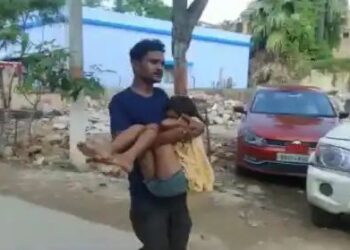So far, India has reported three cases of Monkeypox recently. Although experts across the globe have assured there is no reason to worry as it is not as infectious as SARS-CoV-2, the disease poses a danger to children.
Dr Piyush Ranjan, Department of Medicine, AIIMS told ANI, “The infectivity of monkeypox is less but it can be fatal in children. The COVID-19 infection has more transmissibility, but monkeypox infection occurs after prolonged exposure to an infected person. So, the infection rate is very high in COVID, and an infected person can infect many. But monkeypox is less contagious.”
Symptoms of Monkeypox
Elaborating on the symptoms, Dr Ranjan said the symptoms of Monkeypox are like chickenpox and smallpox. “At the onset, patients will have fever and enlargement of lymph nodes. After 1-5 days, they may report rashes on the face, palms & soles. They may have rashes in the cornea leading to blindness.”
How to Prevent Monkeypox in Children?
CDC has recommended tecovirimat or TPOXX vaccine for children under the age of eight in the US. The vaccine is also available in India, but so far the government has not made any recommendation for administering the virus to children, according to a report by CNBC TV 18. Meanwhile, the World Health Organization (WHO) said it has put the South East Asia region on alert and advised appropriate steps to contain the spread of monkeypox. “The Region has been on alert for monkeypox, countries have been taking measures to rapidly detect and take appropriate measures to prevent the spread of monkeypox,” said Dr Poonam Khetrapal Singh, Regional Director, WHO South-East Asia “WHO has been supporting Member countries in the Region assess the risk for monkeypox and strengthen their capacities to prepare and respond to the evolving multi-country outbreak,” she further said. According to World Health Organization (WHO), monkeypox is a viral zoonosis (a virus transmitted to humans from animals) with symptoms similar to those seen in the past in smallpox patients, although it is clinically less severe. Monkeypox is transmitted to humans through close contact with an infected person or animal, or with material contaminated with the virus. It is usually a self-limited disease with symptoms lasting from two to four weeks, WHO said. Monkeypox virus is transmitted from one person to another by close contact with lesions, body fluids, respiratory droplets and contaminated materials such as bedding. As reported by WHO, since 1 January 2022 and as of 22 June 2022, a total of 3,413 laboratory-confirmed cases of Monkeypox and one death have been reported to WHO from 50 countries/territories. The majority of these cases have been reported from the European Region (86 per cent) and the Americas (11 per cent). This points to a slow but sustained increase in the spread of cases globally. Considering this is the first time that cases and clusters are being reported concurrently in five WHO Regions, WHO has assessed the overall risk of spread of cases as “Moderate” at the global level.










